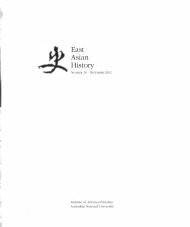Exhibiting Meiji Modernity: Japanese Art at the ... - East Asian History
Exhibiting Meiji Modernity: Japanese Art at the ... - East Asian History
Exhibiting Meiji Modernity: Japanese Art at the ... - East Asian History
- No tags were found...
Create successful ePaper yourself
Turn your PDF publications into a flip-book with our unique Google optimized e-Paper software.
EXHIBITING MElJI MODERNITY<br />
97<br />
upon a screen and "lacquered coffers of every size and shape tied with<br />
silk cords of different colours"; "a multitude of fine inlaid boxes stand<br />
upon <strong>the</strong> ground near <strong>the</strong> mirror". The exquisite objects were for her a<br />
metaphor for <strong>Japanese</strong> society as a whole, a society where "good manners<br />
rise to <strong>the</strong> dignity of a high art"; where "courtesy, gentleness, symp<strong>at</strong>hy are<br />
cultiv<strong>at</strong>ed with <strong>the</strong> same care and skill as this joyous, painstaking people<br />
put into everything <strong>the</strong>y do".<br />
Chief among <strong>the</strong> exhibits in <strong>the</strong> upstairs space was an enshrined<br />
portrait of Sei Shonagon iWY l.f3'§ C965- c.101O), accompanied by a<br />
panel describing this "learned <strong>Japanese</strong> woman who served <strong>the</strong> Empress<br />
Sada Ko in <strong>the</strong> tenth century of <strong>the</strong> Christian era" and offering transl<strong>at</strong>ions<br />
from her famous Pillow Book,97 a collection of sophistic<strong>at</strong>ed and<br />
elegantly written observ<strong>at</strong>ions on court life in <strong>the</strong> Heian +=~ period, a time<br />
when social position demanded of both men and women, a knowledge of<br />
<strong>the</strong> Chinese classics, <strong>the</strong> ability to write elegant poetry and to field classical<br />
allusions in verse <strong>at</strong> short notice. The message of this exhibit was th<strong>at</strong><br />
even a thousand years ago <strong>Japanese</strong> women had been highly educ<strong>at</strong>ed<br />
and exquisitely refined. The rooms, furnished and decor<strong>at</strong>ed with antiques<br />
from <strong>the</strong> personal collections of <strong>the</strong> Empress and noblewomen, reinforced<br />
<strong>the</strong> message. Wh<strong>at</strong> impressed Maude Elliot most, however, was th<strong>at</strong> <strong>the</strong><br />
Empress and <strong>the</strong> women of <strong>the</strong> court had displayed such initi<strong>at</strong>ive and<br />
organiz<strong>at</strong>ional skills in funding, directing and overseeing <strong>the</strong> display.98<br />
<strong>Japanese</strong> women were practical and capable. It is clear from her observ<strong>at</strong>ions<br />
th<strong>at</strong> <strong>the</strong> art in <strong>the</strong> <strong>Japanese</strong> exhibit of <strong>the</strong> Women's Building had<br />
been successful in its public rel<strong>at</strong>ions exercise. The refinement of <strong>the</strong> art<br />
objects reflected <strong>the</strong> civilized character of <strong>the</strong> <strong>Japanese</strong> people, and <strong>the</strong><br />
emancip<strong>at</strong>ion of its women, <strong>at</strong> least amongst its elite.<br />
97 Sei Shonagon, Makllra nososhi, completed<br />
c. 1002.<br />
98 Elliot, Women 's Exhibit, p.37.<br />
The Merit of Progress<br />
The exhibition of <strong>Japanese</strong> fine art was, as we have seen, Japan's bid<br />
for recognition as a civilized country in a context where a country could<br />
not be considered civilized unless it produced fine art. Its success would<br />
be measured in open competition. At <strong>the</strong> Columbian fine art exhibition,<br />
however, <strong>the</strong> organizers did not award ranked prizes, but follOWing <strong>the</strong><br />
general <strong>the</strong>me of progress and improvement, presenting medals and certific<strong>at</strong>es<br />
of merit to works th<strong>at</strong> demonstr<strong>at</strong>ed progress in <strong>the</strong>ir field of<br />
endeavour. This fitted well with <strong>the</strong> <strong>Meiji</strong> n<strong>at</strong>ionalist prinCiple of seeking<br />
Japan's contribution to <strong>the</strong> modern world in its traditional culture. As<br />
described above, <strong>the</strong> <strong>Meiji</strong> art revival was not simply a m<strong>at</strong>ter of reviving<br />
lost or moribund practices, but of developing upon <strong>the</strong> past, taking wh<strong>at</strong><br />
was usable of <strong>the</strong> old as <strong>the</strong> basis of <strong>the</strong> new; cre<strong>at</strong>ing new <strong>Japanese</strong><br />
forms from Chinese precedents, and not hesit<strong>at</strong>ing to take advantage of
















